Buying your first scope
So you want to buy your first scope?
Fantastic! Welcome aboard! There are a few things to consider before you buy your first scope. Hope this guide can give you the questions to ask as you make your decision on choosing the best scope for your purpose.
Purpose of use
This is the big question, and the one that will facilitate the answer of all the below questions. What is the rifle system you are putting together being used for? Is it for hunting, target shooting, plinking or a mixture of each? By now you have probably identified what calibre or type of rifle that you are looking at putting the glass onto which will influence how you proceed, although it's still a long way off from being a forgone conclusion.
Turret type
This is heavily influenced by your proposed purpose of use.
Do you need hunting (capped) turrets which means all of the adjustments are located below a screwed on cap. This may be ideal if shooting a flatter calibre at close ranges or utilising a bullet drop reticle which allows for a hold over point of aim scenario for those longer shots.
Alternatively do you require some versatility for that long range shot by having exposed (tactical/target) turrets which allows adjustment without the need for removing a cap prior to adjustment. If you’re shooting over 600m then this may be more suited. Tactical or exposed turrets should be fully repeatable (accurate throughout their entire range) and have positive tracking (pronounced clicks) when adjusted. Be warned though, unless the scope has a Zero or CRS stop (rifle zeroed and set at a particular distance) it can be quite annoying to lose the zeroed range that is your starting point. Obviously there are ways around this but they can be frustrating, especially in the dark!
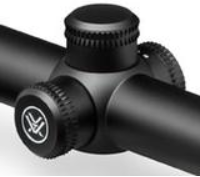
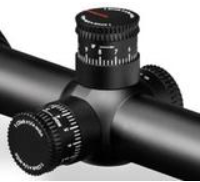
Hunting / capped turrets Target / tactical turrets
Some hunters won't touch a scope with exposed turrets yet some long range shooters won't look at one unless it has that ability to be adjusted easily. Again you need to work what suits your application as there are valid arguments for and against.
As suggested previously exposed turrets trend towards having more adjustment available as they are not limited by the low height caps that hunters crave for. For instance a Vortex Viper HS with hunting turrets only has 42 MOA adjustment whereas the Vortex Viper HS-T with exposed / tactical turrets has 65 MOA.
Reticle type
From first focal plane (FFP), second focal plane (SFP) and illuminated reticles, the sky really is the limit.
First of all you need to decided if you want a ranging reticle (hash reference marks) or just a simplified duplex. Some reticles can be exceedingly complex and appear very busy on the image your looking through, so take care when deciding. If longer range shooting is your preference then possibly a hash marked or a bullet drop compensated (BDC) reticle may be a good start; this allows an instant hold over or reference point when aiming
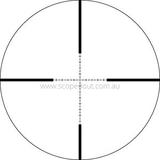
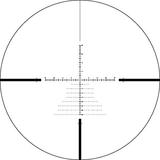
VMR-1 reticle BDC Reticle
First focal plane
This is essentially an image moving reticle which moves whenever the magnification function is enabled. This is the only reticle type that allows for a ranging reticle to be referenced on all magnification settings and as such is the preferred reticle by the military. It is becoming increasingly popular in hunting circles and are becoming more readily available. Unfortunately, the down side of the FFP reticle can be that it is thicker (depending on the type) and can heavily cover the target at some magnifications. They also tend to be more expensive than their second focal plane counterparts
.jpg)
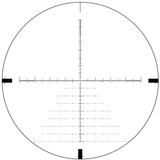
FFP at min. magnification FFP at max. magnification
Second focal plane
This reticle stays exactly the same at all magnification settings so if using a ranging reticle will need to be set at a certain magnification as nominated by the manufacturer. SFP reticles are more in target shooting due to the fact that the when the reticle is magnified it will not hide the target behind a thicker (magnified) reticle.
.jpg)
SFP image stays constant at all magnification
Illuminated reticle
Unfortunately there are a lot of illuminated scopes on the market but for this instance you should really be looking for an etched reticle. This means that the reticle is actually etched into the glass itself or as a fire (centre) dot. Try to stay clear of non etched illuminated reticles as they can be distorted and very imprecise.
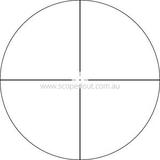
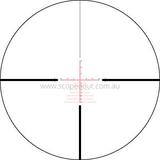
V-Brite EBR-2b
As suggested previously, if shooting at dusk or at night an illuminated reticle can be the difference of getting that extra bit of shooting out of your trip. If you can afford it and you'll use it go for it. If you're never going to need it, possibly spend the extra money to buy that better quality non illuminated glass.
Depending on the reticle type you chose you may even have the ability to stretch the scopes elevation even further as some hash based reticles have the ability to sight the target with 32moa in holdover alone just within the view through the lens!
Adjustment type
This is the unit of measurement used to work out bullet trajectory and is calculated in either inches (MOA) or mils (MRAD). Unfortunately to explain this properly it can start to get complicated so here goes.
MOA or Minute of Angle
These measurements are based on the degrees and minutes of a circle: 360 degrees in a circle, 60 minutes in a degree for a total of 21,600 minutes. These angular measurements are used to estimate range and correction for bullet trajectory drop in rifle scopes. 1 MOA will correspond to 1.05 inches at a 100 yard distance, 2.1 inches at 200 yards, 3.15 inches at 300 yards, and so on
MRAD or Millradian
Mrad unit of arc measurements are based on the radian. A radian is the angle subtended at the center of a circle by an arc that is equal in length to the radius of the circle. There are 6.283 radians in a circle and 1000 milliradians in a radian for a total of 6,283 milliradians (mrads) in a circle. An mrad will subtend 10cm at a distance of 100m (or 3.6 inchs at 100 yards). Most rifle scopes with mrad adjustments use .1 mrad clicks which subtend .1 mrad (1cm) at 100m (or .36 inchs at 100 yards)
Confused yet?
There is the argument that one is metric the other imperial; but again, it's what you think you'll be more comfortable with. The key here is consistency, whatever reticle type you choose it is wise to chose the same type of internal adjustments relative to the reticle itself. For instance, a mildot (mrad reticle) should not be used with MOA adjustments as the reticle is a Milradian based formula. This isn't hugely important for shorter distance shooting but is imperative when using hash marked reticles and tactical style adjustments.
You may also be swayed with who you shoot with. Sometimes it's easier if your shooting partner, father, friend or even club uses a certain measurement type it may be easier to follow suit. It can get trying if when they are spotting for you they keep referring to MOA while your scope is in MRAD!
It really does come down to personal choice and what you feel will work for you and your circumstances.
Lens quality
Unfortunately Lens quality tends to come hand in hand with cost. The better the lens quality or coating on the glass the more you will pay for the scope. There used to be a general rule of whatever you pay for the rifle the scope should be about the same price as that rifle. European scope lens' used to be the pinnacle of the industry yet many manufacturers are now providing great quality from Japan, America and even from the Philippines.
Microscopic coatings on the lens surfaces reduce the light loss and glare due to reflection. Coated lenses offer a brighter, higher contrast image with less eyestrain. The more coatings you have the better the light transmission. However it is still possible to have a rifle scope that has a single coating lens system that will outperform a scope with multi-coated lenses due to the quality of the glass itself.
Acceptable standards for coatings are:
- Coated: A single layer on at least one lens surface
- Fully Coated: A single layer on all air to glass surfaces
- Multi-coated: Multiple layers on at least one lens surface
- Fully Multi-coated: Multiple layers on all air to glass surfaces
It's surprising the difference that is available on the market today with glass quality. For instance a Leupold vx2 from the early 2000's is probably on par now with a vx1 glass due to improvements in machinery and processing methods. Most things do get better over time so you may need to be aware of that if purchasing an older scope. That's not to say that it's not a great idea to purchase an older version but you do need to compare apples with apples.
Tube size
Choosing your scope tube diameter should be simple but the choices are rapidly multiplying. For this instance we will concentrate on the 25-30mm options available as the top tier scopes have an even bigger tube diameter option again (34-35mm) just to complicate matters further!! If you're in the market for one of these scopes though we need to assume that you already know what you're requirements and needs are so we will skip the 34-35mm tubes.
There are many different thoughts and preferences on which is better between the 25-30mm varieties but at the end of the day you choose what fits into your budget or existing kit. You may want to utilise your existing rings for that new scope? It may be that you are changing your shooting discipline which will require an upgrade all-round. You may be looking at changing the purpose of your hunting rifle into something that can multi-task and perform both short and long range shooting. In this instance you may need to upgrade not only your scope but also new rings, non/tapered bases and then any accessories required to assist with that transformation.
25mm tube benefits
- One of the most popular sizes available, a majority of manufacturers have these as a standard option
- Most people have 25mm rings and accessory attachments to suit
- Usually lighter in weight than their 30mm counterpart
30mm tube benefits
- Significantly more allowance for internal elevation and windage adjustment for long range range applications
- may reduce the need to upgrade to a tapered base
- Some manufacturers claim that it has the potential for more light transmission; this is usually more about the objective diameter, quality of the lens itself and the lens coatings
- Slightly stronger than the 25mm alternative
- Allows you to mount the scope tube closer to the rifle
Feel free to contact us to discuss this further as it really does mess with your head sometimes. We are happy to help you in the decision making process and can offer any advice that we ourselves have experienced first hand.
